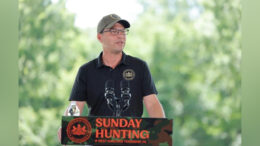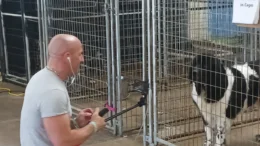BENEZETTE (AP) — Back in 1913, 50 elk were placed on a train near Yellowstone National Park in Wyoming to begin a journey to their new homes in Pennsylvania.
The bulls and cows – confined in boxcars – traveled for 2,000 miles, across plains, through mountains, over rivers and past small towns and major cities.
Finally, the animals, which cost about $30 a head, reached their destinations. Half were placed in Clinton County, the other half in Clearfield County – locations that were specifically selected to be their new habitats. Without any acclimation, the majestic animals left the confines of the train, entered their new surroundings — and promptly wandered far away.
“This kind of becomes political and instead of putting elk where they belong, they put them where they thought was best and to satisfy some people who were interested in seeing elk in their area,” Pennsylvania Game Commission associate editor Joe Kosack said. “So we end up putting elk in places they probably should have never been.
“And, as soon as they get off the boxcar and are released, some of them take off and they don’t stop for 60 miles. We found out right away it takes certain type of habitat to satisfy elk.”
The relocation project was meant to address two issues – overcrowding of elk in Yellowstone and the lack of wildlife in Pennsylvania, where overhunting and habitat destruction led to the last native elk being harvested in either the 1860s or 1870s, with accounts varying.
All total, the Pennsylvania Game Commission brought more than 170 elk into the state – throughout the 1910s and 1920s – mostly in the central region – from as far north as Potter County to Huntingdon County in the south. But they did not thrive, with only a few dozen being alive by the mid-20th Century, mostly in and around Elk and Cameron counties, where they had last lived naturally in the 1800s and are concentrated today.
“It’s pretty rugged country,” Kosack said. “If an elk got wise to being stalked, it could learn to allude hunters pretty quickly in country like that. But, for whatever reason, they managed to make a stand up there, so that’s why we have elk where they are now.”
A census, conducted by Penn State University, put the commonwealth’s elk population at approximately 65 in 1971 before it dropped into the 30s by the middle of the 1970s, likely due to the parasite brain worm. But, through improved habitat management and protection, better scientific understanding of the animals’ patterns thanks to tracking collars, and efforts of several organizations, including the Pennsylvania Game Commission and Rocky Mountain Elk Foundation, the population has grown to a current estimated size of 1,000 to 1,200.
All descendants of the original transplants from the early-1900s, they live in Elk, Cameron, Clinton, Clearfield and Potter counties, although, on occasion some stray from that region, including a bull that ventured into Cambria County in 2010.
Licenses ‘coveted’
More than 30,000 hunters enter Pennsylvania’s annual elk lottery.
In 2019, only 142 tags were given out for the three seasons – Archery: Sept. 14-28 (5 antlered tags, 10 antlerless); General: Nov. 4-9 (27 antlered, 71 antlerless): Late: Jan. 4-11, 2020 (29 antlerless). The hunt is used to generate revenue for the Game Commission, help control the herd’s size and create interest in the elk.
Jeremy Banfield, a Pennsylvania Game Commission elk biologist called it a “very coveted hunt” – with applications coming in from across the nation.
“It’s our best tool – our most efficient tool – for balancing populations with habitat and also with the social acceptance,” Banfield said. “There’s what habitat is available to a population. And that is one balancing act. And there’s a more important balancing act of how many elk are people going to tolerate. So the hunting seasons are our best tools to manipulate the population and change it as much as we can based on those two things. It also provides a tremendous source of a recreational opportunity.”
Its popularity has given rise to a guided hunt industry in the state’s northern tier.
Jeff Colwell, owner of Hicks Run Outfitters in Elk County and a retired conservation officer, has been guiding tag recipients since the elk hunt started in 2001.
“We’ve had 200 successful hunts,” Colwell said during a conversation in his home. “We’ve gotten all of our bulls. We’ve had two cow hunters that we put cows in front of them, but I can’t make the gun barrel not turn to rubber. It’s this new Pennsylvania steel they use to do that. When the hunters see the cow in front of them, it wobbles and they miss.”
Elk hunters are not required to use guides, but most do, including almost 100% of bull hunters, Banfield said.
“There are about five outfitters in the state,” Colwell said. “There are probably 40 guides that work for us five outfitters. I try to run my outfitter business to give you a quality hunt overall – good place to stay, good camaraderie, good food, plus experienced guides that take you out on a one-on-one hunt. Some of the outfitters are taking three hunters and you’ve got coin flips to see who’s going to shoot. I did that one year and didn’t like that.”
Even with all his success guiding other hunters, Colwell has never been selected in the lottery.
“I’ve had as much fun – in all these hunts with these guys I’ve made friends with – by having their dream (come true),” Colwell said.
The majority of hunters selected in the lottery harvest an elk – 95% for bulls, 75% to 80% for cows, according to Banfield. During this year’s recent archery season, all five hunters who got bull tags and five of 10 who received cow tags bagged an elk.
‘Thrill’ of the hunt
John Gilbert put two shots from his .30-06 into an elk.
But the bull was still standing.
Colwell repositioned him. “He got me up against a tree for support,” said Gilbert, a Portage Township resident. “Then I got down on my knees for the third shot and shot off my leg area for the third shot.”
The bullet struck, the elk dropped.
“They’re so immense you could hear it go ‘wooomp’ when it went down,” Gilbert said.
He called the successful hunt, which took place in the Benezette area in 2009, succinctly “a thrill.”
His kill occurred on the fifth day of a hunt during which Colwell led Gilbert into isolated wooded areas. “It was hard,” Gilbert said. “We were in some areas that he said, ‘God is only there every other week.’ I do a lot of walking. I walk two miles a day, cross country through the woods. I do a lot of walking, so he knew that, so we went quite a distance hunting.”
The bull weighed 731 pounds.
“It was all I could do to balance the head and the antlers for pictures because of the immense weight – even just of the antler, the head and the neck area,” Gilbert said.
Gilbert recalled getting about 350 pounds of meat, which meant he needed to buy a new freezer. “It’s delicious meat,” he said. “It just falls apart. Like the best beef you’ve ever eaten – that’s what it tastes like. It’s really good.”
The size of the mount, which measured six feet from the mouth to the tip of the 6×7 antlers, required Gilbert to do some construction work on his house. In one section, he needed to raise his eight-foot knotty pine ceiling to hang the mount on the wall. “It would have been sitting on the floor if I didn’t raise the ceiling four feet,” Gilbert said. “My wife was good enough to let me do that.”
Research projects
The hunt, which is limited to designated zones, is, by far, the most well-known aspect of the state’s elk management practices.
But, behind the scenes, scientific research is being done to help better understand the animals.
Two major projects are scheduled to begin in 2020.
One will involve pregnancy rates.
Information retrieved during the 2013-2018 general hunts showed a 55% pregnancy rate, which Banfield called “low.” But the rate from elk examined later in the winters of 2018 and 2019 showed 88%. “We have evidence of asynchronous breeding, which basically means that animals are being bred later than they should be, based on the natural cycle,” Banfield said.
Beginning in January, the Game Commission will use vaginal implant transmitters that will signal an animal’s collar to send a text message when a birth occurs, so the newborns can be found and collared quickly, as part of a three-year study.
“What that says is it’s good that we’re reaching that almost 90% benchmark,” Banfield said. “What’s bad about it is that almost 40% of them are being bred late in the year. The problem then becomes if you’re bred late, you can’t change the gestation period, your calfs are born late. Is there a function of survival that’s going on there where the calfs that are born when they should be – in late-May, early-June – are surviving well and the ones that are born later have a lower chance of survival because they can’t gain enough weight before winter or they’re more subject to predation or something like that.”
Another project will involve planting half-acre strips of 12 different forage foods, such as red clover, white clover, orchardgrass and fescue grass, located in close proximity to each other, to see what the elk prefer to eat and why.
“The hope is that, of the 12, maybe three to five will float to the top,” Banfield said.
Threat of CWD
Chronic wasting disease – an always fatal, contagious neurological condition that causes a degeneration of the brain, resulting in emaciation, abnormal behavior and loss of bodily functions – could possibly be the biggest potential threat to the elk herd.
It is transmitted through body fluids and environmental contamination of soil, food or water.
There are already three Disease Management Areas for deer in Pennsylvania, including one that covers all of Bedford County, along with most of Cambria and Somerset and part of Westmoreland.
Banfield said no cases have been reported yet in the Pennsylvania elk herd.
But he believes it is coming.
“The pessimistic – but realistic – thing to say here is that elk will get CWD eventually,” Banfield said. “When I first started here in 2013, I was kind of hoping that it wouldn’t happen in my career. But now I do not think that. It will definitely happen in my career.
“Is it going to wipe out our population? Probably not, based on the Colorado/Wyoming model where they’ve had it for 40-plus years. They still have elk. They still have mule deer. But it’s certainly going to have an effect and it’s going to change our management dynamics when that occurs.”
Colwell concurred: “It’s probably, truthfully, coming. That’s a big concern with everybody – tourism, me as a guide, elk hunters and the big thing is the Game Commission. They’re the ones that have to control that.”
Pennsylvania Elk hunt
Information about elk hunting in Pennsylvania:
General season: Nov. 4-9 (27 antlered, 71 antlerless)
Late season: Jan. 4-11 (29 antlerless)
There was also an archery season in September
Hunters may apply for one or all three seasons. Each application costs $11.90. Applications are drawn in August.
Hunting dates 2019
Oct. 19: Squirrels / ruffed grouse / rabbits / quail
Oct. 19: Deer (muzzleloader)
Oct. 26: Pheasants
Nov. 2: Wild turkeys
Nov. 4-9: Elk
Nov. 23-27: Black bear
Nov. 30-Dec. 14: Deer (traditional rifle season)
Dec. 26: Deer (flintlock)






































